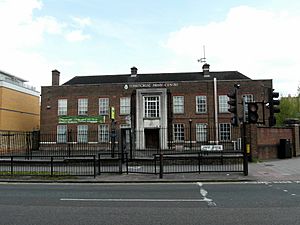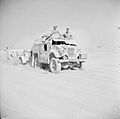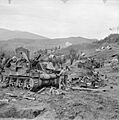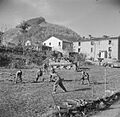Surrey Yeomanry facts for kids
Quick facts for kids Surrey Yeomanry (Queen Mary's Regiment)98th (Surrey & Sussex Yeomanry, QM) Field Rgt, RA 298th (Surrey Yeomanry, QM) Field Rgt, RA 127 (Sussex Yeomanry) Field Sqn, RE |
|
|---|---|
| Active | 1794–1828 1831–48 1901–present |
| Country | |
| Branch | |
| Type | Yeomanry |
| Role | First World War Yeomanry Infantry Second World War Artillery |
| Size | First World War Three Regiments Second World War Two Regiments |
| Engagements | |
| Commanders | |
| Notable commanders |
Col George Leslie, 13th Earl of Rothes Lt-Col Eric Thesiger, DSO, TD |
The Surrey Yeomanry was a special cavalry unit of the British Army. It was first created in 1794. These soldiers rode horses and helped defend Britain.
The unit was started again in 1901. They fought in the First World War. Between the two big wars, they changed from cavalry to artillery. This meant they learned to use big guns.
During the Second World War, one part of the unit was very brave. They helped during the retreat to Dunkirk. They also fought in the Second Battle of El Alamein, Sicily, and Italy. Another part of the unit served in East Africa, the Siege of Tobruk, Iraq, and Persia.
Today, a small part of the Royal Engineers keeps the history of the Surrey Yeomanry alive. This unit is called 2 (Surrey Yeomanry) Field Troop.
Contents
- Early Days: Fighting in the Napoleonic Wars
- The 19th Century: Changes and New Beginnings
- Imperial Yeomanry: A New Era in 1901
- First World War: Fighting on Many Fronts
- Between the Wars: Becoming Artillery
- Second World War: Artillery in Action
- After the Wars: Modern Day Legacy
- Uniforms and Badges
- Images for kids
Early Days: Fighting in the Napoleonic Wars
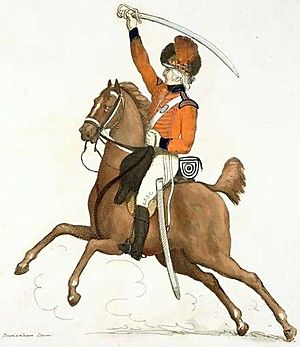
In 1794, Britain was at war with France. The Prime Minister, William Pitt the Younger, asked counties to form volunteer cavalry units. These units were called the Yeomanry. Their job was to defend the country from invasion. They also helped keep order if there was trouble.
Four groups of Yeomanry were formed in Surrey in 1794. They became a regiment in 1797. Lord Leslie led this new regiment. Many members were important people from London.
In 1799, King George III reviewed the Surrey Yeomanry. This happened on Wimbledon Common. Many other volunteer cavalry groups were there too. They were all ready to defend Britain.
After the war ended in 1802, these volunteer groups were stopped. But when the war started again in 1803, they quickly reformed. Some units even changed their names. By 1812, most of these groups had become less active. Only a few, like the Surrey Yeomanry, were still strong.
The 19th Century: Changes and New Beginnings
After the Battle of Waterloo in 1815, the volunteer groups were mostly stopped. Some Yeomanry units continued to help with local security. The Surrey Yeomanry helped keep order during a big event in London in 1820. But by 1828, the whole regiment was disbanded.
A new Corps of Surrey Yeomanry was started in 1831. It became the Surrey Regiment of Yeomanry Cavalry in 1832. However, this unit was also disbanded in 1848.
Later, in 1860, a new mounted volunteer group was formed. It was called the 1st Surrey Mounted Rifle Volunteer Corps. Many members were foxhunters. It changed its name to the 1st Surrey Light Horse Volunteer Corps in 1861. But this group also ended in 1868.
Imperial Yeomanry: A New Era in 1901
In 1899, Britain was fighting the Second Boer War in South Africa. The government realized they needed more soldiers, especially mounted ones. So, they created the Imperial Yeomanry. These were volunteers who rode horses and fought like infantry.
No Surrey units were formed at first. But in 1901, veterans from the Imperial Yeomanry formed a new regiment in Surrey. It was called the Surrey Imperial Yeomanry (The Princess of Wales's). In 1910, it changed its name to (Queen Mary's Regiment). This unit had its main base in Clapham Park. It also had squadrons in Pimlico, Guildford, Epsom, and Wimbledon.
In 1908, the Imperial Yeomanry became part of the new Territorial Force. The Surrey Yeomanry (QMR) was organized with its headquarters at Melbourne House, 73 King's Avenue, Clapham Park. They were trained as Lancers, which meant they used lances (long spears).
First World War: Fighting on Many Fronts
When the First World War began in August 1914, the Surrey Yeomanry was ready. Many soldiers volunteered to serve overseas. Because so many volunteered, a second unit was formed. This was called the 2/1st Surrey Yeomanry. Later, a third unit, the 3/1st Surrey Yeomanry, was created to train new soldiers.
1/1st Surrey Yeomanry: On the Western Front and in Salonika
In late 1914, the 1/1st Surrey Yeomanry was split up. Its squadrons joined different infantry divisions.
A Squadron's Journey
A Squadron joined the 27th Division in December 1914. They were among the first Territorial Force units to go to the Western Front in France. Life there was tough, with Trench warfare. Mounted soldiers couldn't do much fighting on horseback. Their jobs included patrolling roads and delivering messages. They also helped guide supply wagons.
In November 1915, the 27th Division moved to Salonika (modern-day Greece). A Squadron helped with raids and patrols against Bulgarian forces. They even blew up bridges. In 1916, A Squadron joined B Squadron to form a new cavalry regiment. They continued to patrol and raid across the Struma River. In September 1918, they took part in the final Allied attack. They led the advance through difficult land. Their horses became very tired, but they pushed on. The war ended for them when Bulgaria signed a peace agreement on September 30.
B Squadron's Role
B Squadron joined the 28th Division in January 1915. They also went to the Western Front. Their duties were similar to A Squadron's. They patrolled, helped with digging trenches, and filled sandbags. They also helped bury fallen soldiers during the Battle of Loos. In November 1915, B Squadron also moved to Salonika. In December, it rejoined A Squadron to form the new cavalry regiment.
C Squadron's Adventures
C Squadron joined the 29th Division in January 1915. They sailed to Egypt. While the rest of their division fought in the Gallipoli campaign, C Squadron stayed in Egypt. In February 1916, they moved to the Western Front in France.
C Squadron joined other units to form the III Corps Cavalry Regiment. They were heavily involved in the Battle of the Somme in 1916. They sent small groups to help with traffic control and deliver messages. In March 1917, they helped chase the German army as it retreated. Their patrols fought small battles with German rearguards.
In July 1917, C Squadron's horses were sent away. The soldiers became infantry. They joined the 10th (Service) Battalion, Queen's (Royal West Surrey Regiment). They fought in the rest of the war as foot soldiers.
2/1st Surrey Yeomanry: Home Defense and Cyclists
The 2nd Line regiment was formed in Clapham in September 1914. They moved around England, training for defense. In July 1916, they changed from cavalry to cyclist units. They were merged with another unit to form the 8th (Surrey and Sussex) Yeomanry Cyclist Regiment. In March 1917, they became the 2/1st Surrey Yeomanry again. In May 1918, they moved to Ireland. They stayed there until the war ended.
3/1st Surrey Yeomanry: Training New Soldiers
The 3rd Line regiment was formed in February 1915. Its job was to train new recruits. These new soldiers would then join the 1st and 2nd Line units.
Between the Wars: Becoming Artillery
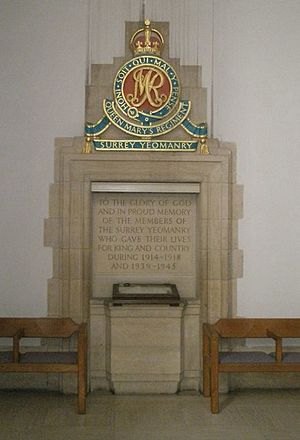
After the First World War, the Surrey Yeomanry (Queen Mary's Regiment) was reformed in 1920. But many cavalry units were no longer needed. So, in 1922, the Surrey Yeomanry changed. They became part of the Royal Field Artillery. This meant they would now use big guns instead of horses.
They joined another unit, the 98th (Sussex Yeomanry) Army Brigade. The new unit was called 98th (Surrey and Sussex Yeomanry) Brigade, RFA (TA). They had two batteries (groups of guns) in Clapham.
In 1938, the unit was renamed 98th (Surrey and Sussex Yeomanry, Queen Mary's) Army Field Regiment, RA (TA). When the Territorial Army was doubled in size in 1939, the Sussex Yeomanry parts formed a new regiment. This left the 98th Regiment with its two Surrey Yeomanry batteries.
Second World War: Artillery in Action
98th Field Regiment (Surrey & Sussex Yeomanry Queen Mary's)
Battle of France: Heroic Stand at Dunkirk
The regiment went to France in September 1939. They had older 18-pounder guns from the First World War. When Germany invaded in May 1940, the regiment moved into Belgium. But the German army broke through quickly.
On May 22, 1940, one of their batteries, 392 Battery, was sent to defend bridges. They had only seven guns. Each gun was sent to cover a bridge against the advancing German tanks.
- At Hazebrouck, a gun stopped an enemy column. It knocked out lead vehicles. Even when attacked by 11 tanks, it destroyed one or two before the crew was wounded.
- At Saint-Momelin, a gun held its bridge for three days. It destroyed enemy houses and mortar positions. The gunners even heard a German radio message saying: "Bridge at Momelin strongly held, try elsewhere." This delay was very important.
The regiment then had to retreat to Dunkirk. They had to destroy their guns and vehicles. The soldiers then walked to the beaches to be evacuated back to England.
Home Defense: Protecting Britain
Back in England, the regiment helped defend the coast. They used old naval guns on trucks. They also manned roadblocks. By April 1941, they had new 25-pounder guns. They trained at different locations in England.
North Africa: Fighting in the Desert
In September 1942, the regiment went to Egypt. They joined the 10th Armoured Division in the Eighth Army. They fought in the Second Battle of El Alamein. Their guns supported tank attacks. After the battle, they helped chase the enemy.
In Egypt, they got new self-propelled (SP) guns called M7 Priest. These guns could move on their own.
Sicily and Italy: Pushing North
In July 1943, the regiment joined the Allied invasion of Sicily. They landed on July 10. They supported infantry and tanks in battles like the one at Primosole Bridge. They helped the infantry cross the Simeto River.
After Sicily, the Eighth Army invaded mainland Italy. The regiment landed in Italy in September 1943. They fought in tough battles, including the crossing of the River Sangro. They fired over 600 rounds per gun in three days. They also supported attacks on the Moro River and the River Gari.
North West Europe: Final Battles
In March 1945, the regiment moved to North West Europe. They got new Sexton 25-pounder SP guns. They served in the Netherlands and Germany. The war ended in May 1945. The regiment was officially stopped in June 1946.
144th Field Regiment (Surrey & Sussex Yeomanry Queen Mary's)
This regiment stayed in the UK at the start of the war. In November 1940, they went to Egypt. They served in Sudan, Ethiopia, and Eritrea. In Eritrea, 390 Battery was charged by about 60 Eritrean cavalry. This was likely the last cavalry charge against the British Army.
The regiment then fought in the Siege of Tobruk in September 1941. After that, they served in Iraq, Syria, Persia, and other places in the Middle East. They stayed in this region until the end of the war.
After the Wars: Modern Day Legacy
In 1947, the 98th Regiment was reformed as the 298th (Surrey Yeomanry, Queen Mary's) Field Regiment. Over the years, it merged with other units.
In 1967, the unit was disbanded. But it reformed in 1969 as a troop within another regiment. Its name and history continued through various changes.
Since 1999, the history of the Surrey Yeomanry is kept alive by 2 (Surrey Yeomanry) Troop. This troop is part of the Royal Engineers. They are based in Redhill.
Uniforms and Badges

The first Surrey Yeomanry wore a light blue uniform. This was unusual for British military units. They had silver decorations and a large red feather on their helmet.
After the South African War, many Yeomanry regiments changed to khaki uniforms. The Surrey Yeomanry adopted a khaki uniform like the New South Wales Lancers. But they added a bright red front piece and green feathers to their hats for parades. Later, in 1912, they got a dark blue uniform for formal events.
During the Second World War, soldiers wore their Surrey or Sussex Yeomanry badges. They also had a special shoulder patch. It said 'SURREY & SUSSEX' over 'YEOMANRY Q.M.R.' in yellow on a blue background. In the Middle East, they used brass badges.
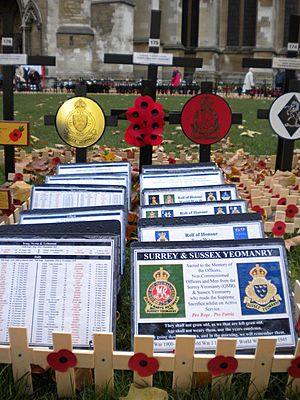
Images for kids
-
A patrol of C Sqn 1/1st Surrey Yeomanry passing through the ruined village of Caulaincourt during the German retreat to the Hindenburg Line, March 1917.


